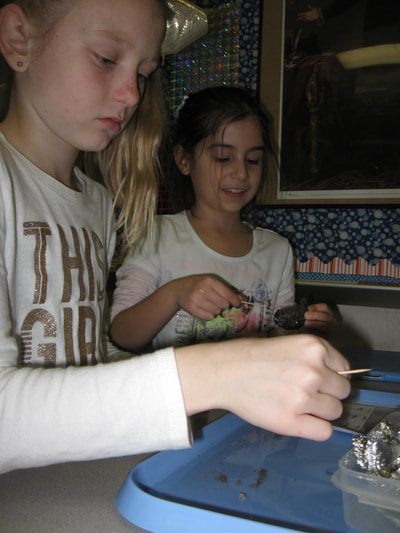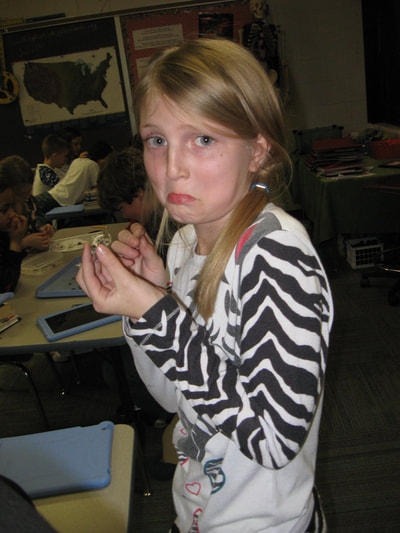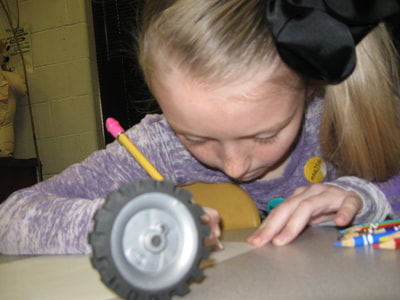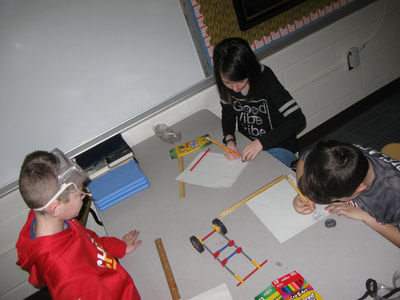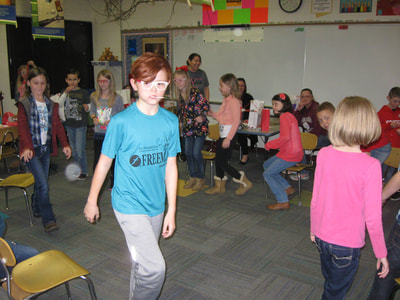| We have come to appreciation Captains Meriwether Lewis and William Clark (veterans, by the way) for all that they achieved on their Corps of Discovery expedition. One task at which they excelled was chronicling their scientific discoveries. Lewis and Clark took extensive notes about the flora and fauna of the West. Yesterday, we devoted some time to exploration and discovery of our own. I introduced the class to owl pellets. We began by learning about owls (and other birds) and their digestive tracts. This information is presented in a colorful way in the Owl Pellet Essentials Guide, but not ever as colorfully as the actual hands-on dissection that followed. Each group was provided an extra large pellet to explore, along with some extra scientific observation tools which included a bone identification sheet, toothpicks, and a magnifying glass. | This class didn't have any apprehension at all. Students quickly dug into the materials and recorded their experience along the way. |
|
0 Comments
I often tell my class that even if they can't do a problem, they should at least approach the problem.
If they are not willing to approach it, they will never be able to conquer it. "It takes a whole ocean
and the moon to erase your mere footstep from the sand" (unknown). (LIBERTY) BELL WORK We should be flattered that the principal has asked our class to be observed by another teacher-intern. In addition to our intern from MSU (See yesterday's post.), we have been asked to host another young lady pursuing a career in education. Our second intern, Christina Fairlie, is expected to spend about 20 hours in our classroom as she progresses toward teacher certification. She comes to us from Crowder College.  A few weeks ago, Principal Bozarth asked if I would be willing to host a teacher-intern from Missouri State University in Springfield. Next Wednesday will be the first day Mrs. Friend will visit our class - the start of about ten weeks of her observations of our classroom management and instructional skills. Her clinical supervisor will also visit a couple of times to observe her teach a lesson. Not only is Cheyenne Friend going to intern in our class; she actually attended our school a years ago, and she substitutes here. In her first email to me, she flatters us (and mentions she knows a couple of my former students): I received the news this morning and I simply cannot thank you enough for taking me under your wing and letting me be in your classroom. I am so excited about being placed in a class that has such a wonderful reputation and (as my younger sister and husband remembers) a fantastic teacher! Really, thank you. I am there to support you in any possible way that I can and I hope that you will take advantage of having the additional support. The class and I are excited to help Mrs. Friend in her studies and development as a future teacher.
As we continue to move forward in our fraction lessons using Eureka Math, the class has also sampled an online resource. The resource is called Zearn, and it correlates quite well with Eureka. Students feel like the earliest lessons have been too easy, but as they advance and Zearn catches up to our lessons, students should start to feel more of a challenge. With their usernames and passwords, students can feel free to work with this resource from home, as well.
 The principal calls me a weirdo. The other teachers think I'm strange. I have a unique duty at Cecil Floyd. This duty comes at the end of the school day, when I play the part of the Speed Bump at the end of the pickup line out front. I stand between the two lanes of vehicles and guide students safely to their cars. The purpose of the Speed Bump is to keep traffic from trying to subvert the line and drive down the center while students are crossing and loading. Knowing that the adults are more easily seen than the kids, we step in front of cars before allowing students to cross, . Some parents make the effort to thank me, every day. Some recognize that this is a safety issue. Some recognize that, like the postal carrier, we are out there in rain, sleet, and snow - every day. I've come out of this duty soaked to the skin. I've been confronted by wind, heat, rain, snow, and varying combinations of these. Somehow I enjoy the extreme days. Fighting an umbrella through needles of water, splashing through puddles to safely load our children into their warm cars invigorates me. And that's when the principal calls me a weirdo. Yesterday, it was cold, but we've seen colder. The threat of ice was in the air, but we've seen worse. Still, for some reason, I was reminded of a severe weather event that I experienced several years ago: before I started teaching, I held another job - in an outdoor recreation area and fish farm in El Reno, Oklahoma. On this particular day, we had a mediocre crowd on the property, fishing around our 10-acre lake and another small pond, picnicking along the covered bridge, petting animals in the barn, and admiring the wildlife we had on display. It was another time when the weather quickly changed. A wind blew in from the northwest. The temperature suddenly dropped. Rain began to fall. And hail the size of golf balls pummeled anything that was outside. The ground was white with hailstones. People ran for cover, mostly in the little admissions building where I was working. Then I remembered the paddle boats. Earlier, people had rented paddleboats for fishing in the larger part of the lake. Through the storm, I counted the boats at the dock to discover that we were two short. One was easily located on the shore line, but the other was harder to locate. At the far end of the lake, I barely made out the boat, half sunk at the far end of the lake against the earthen dam. This was bad - about the worst thing that could happen. The boat had been blown to the south side of the lake, and a man and a woman were sitting on the sharp incline of the dam. I couldn't stand in the building at the top of the hill, knowing these people were fighting for their lives being bruised by balls of ice. I prayed that all the people had made it to the muddy shoreline anyway. How many were on the paddleboat to begin with? I sprung into action (I was much younger and lighter in the 80s.). In a back room I found a surplus olive green military jacket, threw it around myself, and told the people in the admission building I where I was headed. Without any other protection, I plunged into the rain, barely noticing the hail, still the size of golf balls, that bulleted my head. I made my way through flooding creek beds and swampy reeds until I finally reached one end of the dam. Water swept over a low spill way built into that location. I crossed the rushing water forgetting that such a current could easily sweep me to my death - a rescue attempt gone bad. Once across the "river", I now faced a six-foot tall barbed fence with the strands too close and too tight to climb through (The fence was in place to keep the buffalo herd from crossing into a different area of the property.). To cross the fence, I removed the army coat (By now the hail was subsiding to the thick rain.) and threw it over the top strand of barbs. Climbing the fence with the coat in place, I didn’t have to worry about avoiding the barbs. Once on the other side, I recovered the coat and climbed the muddy incline to the top of the dam. I didn’t think those people would be able to go back down the slick mud or cross the rapids I had just faced, let alone climb the fence as I just had, so I made the decision to take the “long way home”, opting instead to go forward across the dam and into the other pasture. We still had to cross another fence and ended up sliding in even more mud along the rail bed that had been prepared for a train the property owners had purchased. This turned out to be a real pain as we slid along the treacherous route, finally coming through the gate into the barn area. I'm still impressed that I was able to spring into action so decisively. I probably couldn't do it today without ending my life at some point along the way. But I still remember that cold, wet afternoon, with hail bombs raining on me as I saved a man and woman from what could have been tragedy for them, as well. I got them off of that dam, onto higher ground, and to safety...just in time for the sun to break through the clouds. I guess that's what I remember when someone thinks I'm doing something special by standing in the gale-force winds of the school parking lot. That's the battle I recall when someone thanks me for braving the curtains of winter rainfall, when the freezing rain soaks into my socks, and when my hands feel like an elephant is standing on them because of the cold. Perhaps I picture myself reuniting children with their families during even more extreme conditions. Suddenly I am a first responder - serving my community with pride, integrity, and guts. Somehow, I enjoy the rush that comes in those situations. No, I'm not facing down an EF5 tornado or some kind of sweeping tsunami, and no, we're not evacuating because of raging wildfires, but I'm happy to be out there nevertheless. While others may moan about that duty taking too long...while others may think it is a thankless job...while others despise having to stand in the middle of the street while the rest of the staff stands inside a heated cafeteria, I kind of get a little thrill from the change of pace. Maybe I am a weirdo for enjoying the hardships of dismissal duty in the school parking lot. While that may be true, I think l will wear that badge with pride.
There's Trouble in the SouthThere are, of course, many accounts of the Revolution in the South. One part of the story is described in the Liberty's Kids episode (below right), while another is the account of the Swamp Fox, Francis Marion.
Read more about The Swamp Fox and be ready to discuss his exploits with the class.
While We're On the Subject
Welcome to the WetlandsThere is a lot to be said for swampy areas, otherwise referred to as wetlands. Some explore these lands in much the same way as Francis Marion and his men, avoiding snakes, alligators, and leeches, fighting mosquitos and stagnated water. Others skate across the surfaces of swampy waterways by means of an airboat. Yes, there is much to be said for our wetlands. As we transform our classroom into this ecosystem, we will need to study the flora and fauna through a series of activities. The Ducks Unlimited Teacher's Guide to Wetland Activities will provide us with some projects for this study. Working togetherMarion's men had to work together to maneuver the swamp. You will be divided into teams. The goal for your team is to get to the other end of the swamp without being chomped by the gators. Stay on the newspaper provided, or your team will have to start over. Note: I will give you one less newspaper page than members on your team. GullahIn the early 1700s, a different culture was brought to South Carolina shores. The Gullah culture still exists in pockets, but their unique experiences with slavery and survival are present in much of today's African American culture. It has been said that the Gullah people are the nearest link to Africa we have in the United States. This culture was well established and still developing in the cotton and rice fields of South Carolina while Francis Marion was mounting his surprise attacks on the British during the latter half of the 18th century. Brought to the U.S. for their expertise in the rice fields, these people continued to survive in the islands for many years, but slowly the culture is dying out.
Interested in learning more about this incredible culture? Check out the Ultimate Gullah website.
Principal Bozarth has compiled some grade level data based on the latest predictive tests our classes took. You will hear us refer to these tests as NWEA testing. It's important to note that the information Mr. Bozarth brings is compiled from grade level results and not solely from our class. This group of students also took the NWEA tests in third grade. Here is their progression so far (sans the fall 2017 scores). This percentages here indicate the percentage of students who scored at the Advanced or Proficient levels.
We can look at this data from a different perspective, comparing the last couple of years of our fourth grade team. Looking at the information in this way means we are no longer comparing the same group of students (as in the numbers above), but that we are comparing three different classes. This still has value as we look for trends.
We are pretty confident that our scores would increase if we were to take the NWEA test again in the spring. If that holds true, our fourth grade team looks to raise our scores once again, this year.
We offer our thanks to Mr. Bozarth for paying attention to the results of our classes and providing us leadership and respect along the way. He will deliver this information to Superintendent Moss.
That's the address of one of the most recognizable building in the world - the White House. Some very important people have lived here, starting with the second president of the United States. That means George Washington never lived in the White House.
Our room parent (and helpers) turned out another high energy and organized party for this school year. Students played a relay game, guessed the number of Kisses in a jar, played musical chairs, and opened their valentines. Whew!
|
AnthemThe Hoggatteer Revolution
is an extensive, award-winning, inimitable, digital platform for Encouraging and Developing the Arts, Sciences, and honest Christianity in the beautiful, friendly LAND OF THE FREE AND THE HOME OF THE BRAVE This site is described as
"a fantastic site... chockablock full of interesting ideas, hilarious anecdotes, and useful resources." 
...to like, bookmark, pin,
tweet, and share about the site... and check in regularly for new material, posted often before DAWN'S EARLY LIGHT! History in ResidenceElementary Schools: Bring Mr. Hoggatt into your classroom for a week of engaging and rigorous history programming with your students. LEARN MORE BUILDING BETTER
|





